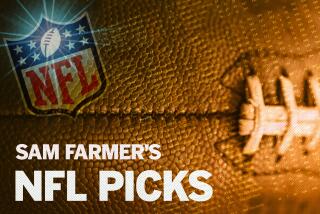When six NFL teams need answers, they call Studio City stat man Bud Goode. With the playoffs underway and a Super bowl to go... : His Days Are Numbered
- Share via
Once upon a time, a long, long time ago, when football helmets were made of form-hugging leather and women’s pants were not, National Football League statistics were rather simple.
The league made available such things as rushing yards and passing yards, and coaches kept track of things like number of interceptions.
Those were the good old days. Welcome to the Goode new days, courtesy of Bud Goode, a man who never met a statistic he didn’t like.
Goode, of Studio City, is to statistics what Joaquin Andujar is to bad tempers or the Los Angeles Kings are to bad hockey. For many, many hours a week he sits before his computer in Westwood and plugs in numbers. What the whirring and wheezing mechanical brain spits back is volumes and volumes of statistics about the NFL.
What kind of statistics? Well, how about such traditional barroom conversation topics as touchdowns on opponent interception returns. Plays per first down and the differential between any of the 28 teams? Or average plays per touchdown?
Goode, 62, has developed 151 statistical categories. He retabulates each of them weekly, and also keeps constant track of how each statistic relates to any other statistic. Through this incredibly complex system, Goode discovers statistical reasons why NFL teams win or lose.
For this service, he is paid well by six NFL teams. He could have many more of the NFL teams on his subscriber list, but he limits access to one team per division.
It may or may not be coincidence, but four of the six teams that employ Goode--the Chicago Bears, New York Giants, New England Patriots and the Rams--are in the playoffs and will playing this weekend in second-round games.
“Each of my six teams gets three pounds of statistics each week,” Goode said. “It helps them prepare for the next opponent and shows the strengths and weaknesses of their team and the team it will play. It also shows your offense looking at their defense and their defense looking at your offense.”
Once in a while, two of Goode’s teams face each other. It happened a few times during the regular season and will happen again Saturday when the Giants take on the Bears. On those days, Goode sits in front of the television. Nervously.
“In any game, I look for mistakes,” he said. “Mistakes kill a team. I hate mistakes. When two of my teams are playing each other and one team makes a mistake, I throw my cat at the TV.”
Of the 151 groups of statistics that Goode charts, one of the most important, he says, is called points per pass attempt, which measures the balance between the run and the pass. Goode says that statistically, the way to win in the NFL is to run the football. Over and over again. And points-per-pass invariably shows that most teams pass the ball too often.
“Points per pass explains how the game is played,” he said. “Teams that lean on their running game protect their defense and eat up the clock. If you do that, you’ll win, consistently. If you don’t, you probably won’t win.
“For the Rams, Eric Dickerson and the two guys who do most of the blocking for him, Bill Bain and Dennis Harrah, are the team’s most important defensive players. They keep the real Ram defense off the field and, most importantly, they keep the other team’s offense off the field.”
The run, Goode said, became more and more important as the 1985 season wore on. It showed up in both the won-loss records and the margin of victory. Goode’s stats show that teams ran the ball 40 or more times on 69 occasions during the season. Those teams won an incredible 67 of those games. And Goode assigned a full point in the winning margin for each running play. For example, if your team ran the ball 40 times and your opponent had only 30 running plays, you should expect to win that game by 10 points.
The Bears led the NFL in winning margin, winning by an average of 16 points a game. Not coincidentally, the Bears also ran the ball more than any other team, averaging 15.7 more running plays per game than their opponents.
The second-best running team in the NFL was the Giants. Expect a three-yards-and-a-cloud-of-dust game this weekend. Or, because the game is in Chicago, something more along the lines of three yards and a mound of snow.
Another big statistic in Goode’s computer is called yards per pass, and the Giants lead the NFL defensively in that area, allowing only 4.7 yards per pass. The Bears rank fourth, allowing just 6.5 yards per pass. So again, the need for a concentrated running game by both the Bears and Giants is shown, Goode said.
Adding to a pass-hungry team’s woes is this Goode statistic: A team that gives up two interceptions in a game will lose four out of five times. If you give up three interceptions, you will lose the game, almost without exception.
A team that passes a lot usually opens itself up to a lot of sacks, also. Sacks, Goode says, are as detrimental to winning football as having a team of slow, old, skinny guys on the line.
“In 1984, a sack was worth three points in the winning margin,” he said. “This season it jumped to 3.3 points, a 10% jump, which is a big jump.”
Eight of this season’s playoff teams ranked in the top 11 in the league in a Goode statistic called defensive sack percentage. That list is headed by the Raiders and Giants, who sacked the quarterback 13% of the time--one out of eight--on passing plays. The Bears and Seattle Seahawks were tied for second at 12%, followed by Dallas, Washington and Philadelphia at 11% and the Rams, Patriots, Jets and 49ers at 10%.
Because a sack increased in actual value in the winning margin this season, Goode advised his teams to gamble more and go after the sack more frequently than they did in 1984. The Giants may have listened. They led the NFL with an average of 4.2 sacks per game, compared to the league average of three per game.
“In the Bears-Giants game, that sack percentage figure is the one I will watch for,” Goode said. “If the Giants come up with more than one sack in the first quarter, I’d have to say at that point that their defense is going to have a big, big advantage in the game.”
In the Raiders-Patriots game Sunday, Goode said one key will be the percentage of complete passes thrown by the Patriots. New England has completed 51% of its passes this season, ranking very high on the NFL list. The Raiders’ defense, however, has allowed only a 44% completion rate, which ranks them very high on the defensive list.
The other key, Goode said, will be the Patriots ability or inability to get first downs on the ground. New England has averaged a whopping 7.9 rushing first downs this season, but the Raiders have allowed only 4.6 rushing first downs per game, leading the NFL in that defensive stat.
Goode said each rushing first down by the Patriots will be worth two points in the winning margin.
“In that game, I will ask, ‘Can the Patriots earn a first down on the ground?’ If they can, if they can get two of them in each quarter, then they can easily win that game,” he said.
Goode also, on occasion, will translate a statistic into English: “But that Raider defense is a bitch to run against,” he cautioned.
Down the road in Anaheim, Goode said a key will be how the Rams’ offensive line handles the Cowboys’ pass rush.
“The Cowboys are No. 4 in sacks in the NFL, and the Rams are No. 23 in allowing sacks. So there’s the obvious strength versus weakness stat that you have to keep your eye on,” Goode said.
But, he points out, the Cowboys may have even a tougher time scoring than the Rams.
The Rams’ defense ranks fifth in the NFL in yards allowed per rush, only 3.6. The Cowboys’ running game, Goode pointed out, has been in a dramatic slide since about the fifth week of the season and now averages only 3.8 yards per carry, near the bottom of the NFL heap in that stat.
“The stats tell us this: Look for the Cowboys to get in Dieter Brock’s eyes all day long,” Goode said. “But, the Rams will force Dallas to pass much more than they’d like to, and that second Ram interception will win the game for them. Pick the Rams by seven points.”
Stats. Piles of stats. Mountains of stats. More numbers than a state prison photo album. So, we ask the Bud Goode Sports Computer service, which team will win the Super Bowl? The man that makes the giant machines talk says that’s an easy one: the Bears.
“One of the best indications of a team’s overall strength is the number of points they score versus the number of points they allow,” Goode said. “The Bears right now have a 2.3-1 ratio, far and away the best in the league. The next-best team, the San Francisco 49ers, scored 1.56 points for each point they allowed.”
The Jets, also bumped from the playoffs, were third at 1.49-1 followed by the Giants (1.41-1), Miami (1.34-1), New England (1.25-1), the Rams (1.23-1) and the Raiders (1.15-1).
“The Bears have been just unbelievably strong this season,” Goode said. “Their winning margin has been at 15 or 16 points all season, and the typical Super Bowl champion in the last decade has only had a winning margin of about 10 points.”
Bud Goode has spoken. Walter Payton and Jim McMahon and William (the Refrigerator) Perry--who would need a computer to keep track of one day’s calorie intake--will be doing their Super Bowl Shuffle on the night of Jan. 26 in New Orleans.
Goode Playoff Advice
RAMS VS. COWBOYS: The Rams offensive line must handle the Cowboys’ pass rush. The Cowboys are No. 4 in the NFL in sacks.
RAIDERS VS. PATRIOTS: If New England can get first downs by rushing, look out. But the Raiders have allowed only 4.6 per game this season.
GIANTS VS. BEARS: The number of sacks a team gets is worth 3.3 points to the winning margin. The Giants average 4.2 a game.
THE SUPER BOWL: The Bears will win, says Bud Goode. They outscore their opponents at a 2.3-1 ratio--far and away the best in the NFL.
More to Read
Go beyond the scoreboard
Get the latest on L.A.'s teams in the daily Sports Report newsletter.
You may occasionally receive promotional content from the Los Angeles Times.










